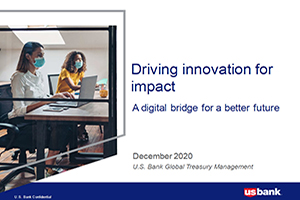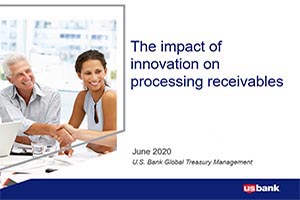Artificial intelligence can greatly increase the efficiency of corporate treasury management but maximizing AI benefits requires understanding its limitations along with capabilities.
Artificial Intelligence (AI) has made its way into daily life, from autocorrect on a smartphone to predictive search engine suggestions. When considering AI in finance, CFOs, treasurers, and cash managers are asking important questions such as how AI can support functional operations, and how to capitalize efficiencies now for future business objectives, i.e. growth.
“AI means different things to different players in the treasury management ecosystem,” says U.S. Bank Global Treasury Management Senior Vice President and Head of Digital Transformation, Vipul Kaushal. “It’s critical to understand what AI can do today versus future possibilities.”
Understanding existing AI technology capabilities in terms of future opportunities mean corporate treasurers can begin to make strategic decisions ahead of their competition.
By committing present-day AI capabilities to make foundational processes more efficient and effective, treasurers are proactively positioning their organizations to harness future-state AI, where rapidly-increasing business applications are a competitive advantage against the constant rate of change.
Is treasury management ready for artificial intelligence?
Before seeking technology solutions, treasury management departments need to clearly understand and systematically improve how their teams work. Most companies won’t know how AI can improve business unless they’ve critically examined existing processes first.
Flaws in processes develop over time as a result of workarounds to accommodate exceptions, or from underinvestment in technology. Regardless of their origins, flawed processes incur hidden costs, often in the form of wasted employee time or project delays. While these costs may initially appear incremental, they can quickly amount to millions.
To understand where treasury will benefit most from AI, Kaushal suggests treasurers first identify core processes, analyze inefficiencies, as well as their direct and indirect costs. Then, a determination can be made where AI technology can enhance or assume those tasks, and treasury managers can optimize operations.
How can artificial intelligence enhance treasury?
AI is a broad and fluid category of computer science that attempts to solve problems that were previously believed to be only solvable by human intellect. The definition of AI evolves as technology advances, and some AI applications are now so commonplace that many people don’t see them as AI. This evolution is named the AI effect.
But commonplace doesn’t mean the evolution has halted. In fact, business opportunities for AI are developing faster than ever. In many cases, AI is already making treasury more efficient within all phases of the working capital cycle by creating visibility and operational scalability



















































